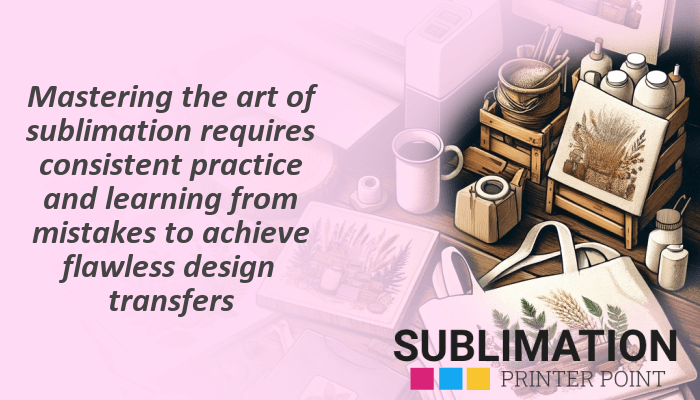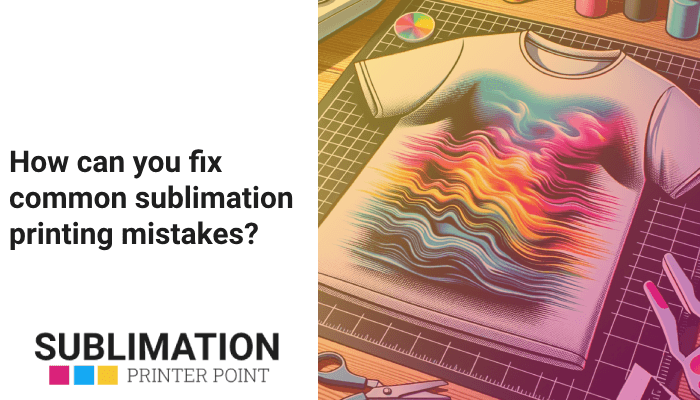Learn about common mistakes and troubleshooting techniques in sublimation with this comprehensive guide. Learn the secrets of high-quality sublimation printing, a method that uses heat to transfer dye to a variety of materials.
The flexible process of sublimation printing uses heat to transfer dye onto materials to produce vivid, long-lasting prints. Important parts like the print head, ink cartridges, and heat press are involved. It’s not without difficulties, though. Typical errors include mishandling color, setting the temperature and time incorrectly, and applying pressure incorrectly. Effective troubleshooting methods, such calibrating the heat press machine and checking the sublimation blanks, are required to fix problems. Additionally, printing skills can be greatly enhanced by knowing the sublimation process, employing the proper materials, and maintaining the printer.
- Sublimation printing uses heat to transfer dye onto materials.
- Key components include the print head, ink cartridges, and heat press.
- Common mistakes involve color management, temperature and time settings, and pressure.
- Troubleshooting techniques include adjusting the heat press machine and inspecting the sublimation blanks.
- Understanding the process, using the right materials, and maintaining the printer can improve the printing techniques.
What is sublimation printing and how does it work?
The innovative technology of sublimation printing uses heat to transfer color onto materials including card, cloth, and plastic. Unlike traditional printing, this process skips the liquid phase and instead entails a transition from a solid to a gas state. Many firms use sublimation since it is an essential method for producing brilliant, long-lasting prints. Understanding this process is crucial because, in contrast to conventional printing techniques, it can yield high-quality prints that are resistant to peeling and breaking.
What are the key components of a sublimation printer?
A sublimation printer is an intricate apparatus consisting of multiple essential parts. These consist of the ink cartridges, which hold the sublimation ink, and the print head, which applies the ink onto the sublimation paper. Additionally, the printer has a heat press that uses pressure and heat to transfer the picture onto the substrate. Comprehending these constituents is vital in order to resolve any potential complications that may emerge throughout the sublimation procedure and to enhance the printer’s efficiency.
How does heat transfer play a role in sublimation printing?
The foundation of sublimation printing is heat transfer. The sublimation ink changes from a solid to a gaseous form due to the heat, which allows it to penetrate the substrate. An excellent, long-lasting print that is resistant to fading and wear is produced by this procedure. It is important to recognize that heat transfer plays a crucial role in producing high-quality prints because it is the trigger for the entire sublimation process.
Did you know that precise color representation in your prints depends on the type of sublimation ink you use? Brands with a reputation for excellence in sublimation inks include Sawgrass and Epson. Additionally, managing colors efficiently with the use of an ICM (Image Color Management) profile will assist lower the likelihood of color disparities in your prints.
What is the role of sublimation ink and sublimation paper in the process?
Paper and sublimation ink are essential elements in the sublimation printing process. The ink, created especially for this procedure, is heated to a gas, which penetrates the substrate and solidifies into its fibers. In contrast, the sublimation paper is made to retain ink and, when heated, release it uniformly. Ink and paper have a symbiotic relationship that is essential to producing vivid, durable prints, highlighting their significance in the sublimation process.
What are the common mistakes in sublimation printing?
Despite being an effective technology, sublimation printing is not without its drawbacks. Erroneous printing pressure, temperature, and timing, as well as color management problems, are common errors. These mistakes can waste time and resources by producing prints that are not up to par. The first step in fixing these frequent errors and achieving better print quality and efficiency is identifying them.
What issues can arise with color management in sublimation?
One of the most frequent problems with sublimation printing is color management. Incorrect color profiles can cause problems and result in prints that are too dark or too light. In addition, color disparities may arise from the incorrect kind of sublimation ink. Comprehending the nuances of color management is essential to generating prints that faithfully capture the original artwork, underscoring the significance of this facet in sublimation printing.
How can incorrect sublimation printing temperature and time affect the outcome?
The results of sublimation printing can be significantly impacted by incorrect temperature and time choices. Insufficient heat might lead to partial transfer, while excessive heat can cause the ink to bleed. In the same way, improper timing can result in either over- or under-sublimation, both of which degrade the print’s quality. Achieving the best possible results with sublimation printing requires an understanding of the significance of precise temperature and time settings.
Not applying the proper pressure during sublimation printing is a typical error. Recall that excessive pressure can spread the ink and produce fuzzy images, while insufficient pressure can result in only part of the transfer being completed. To prevent these problems, check the settings on your heat press machine frequently and make any necessary adjustments.
What problems can be caused by improper sublimation printing pressure?
When sublimation printing, incorrect pressure can result in a variety of issues. While little pressure may lead to partial transfer, excessive pressure might cause the ink to spread and produce hazy images. Comprehending the significance of pressure in the sublimation process is important for generating prints of superior quality, underscoring the necessity of accurate pressure adjustments.
How can you troubleshoot sublimation printing problems?
Although troubleshooting sublimation printing issues might be difficult, it can be done with the appropriate methods. Determining the source of the issue, whether it is a fault with the heat press machine, the printer, or the sublimation blanks, is essential to effective troubleshooting. Equipped with this understanding, you may address the problem and enhance the effectiveness of your sublimation printing procedure.
What are some effective sublimation printing troubleshooting techniques?
Sublimation printing problems can be solved with a methodical approach when using effective troubleshooting procedures. This include examining the sublimation blanks for flaws, verifying the printer settings, and modifying the heat press equipment as necessary. When used properly, these methods can assist fix typical problems with sublimation printing, improving the effectiveness and quality of the final product.
How can you adjust the heat press machine to fix issues?
One of the most important steps in troubleshooting sublimation printing is to adjust the heat press machine. This entails making sure the pressure and temperature parameters are suitable for the substrate being utilized. To guarantee optimal operation, the heat press machine should also undergo routine maintenance. Resolving sublimation printing problems and enhancing the printing process as a whole require an understanding of how to maintain and adjust the heat press equipment.
What role do sublimation blanks play in troubleshooting?
When troubleshooting sublimation printing problems, sublimation blanks are a crucial component. Checking the blanks before usage is crucial since poor print quality might result from defective or subpar blanks. It’s also important to know the qualities of the blanks being used because different materials have varied requirements for heat and pressure. The effectiveness and caliber of the sublimation printing process can be enhanced by understanding the function of sublimation blanks in troubleshooting.
What are some tips and tricks to avoid sublimation printing mistakes?
Achieving high-quality prints requires avoiding sublimation printing errors. This entails knowing how sublimation works, using the appropriate supplies, and adhering to a thorough sublimation printing lesson or guide. By using these pointers and techniques, you can steer clear of typical errors and enhance the effectiveness and caliber of your sublimation printing procedure.
What are some useful sublimation printing tips for beginners?
It’s important for novices to grasp the fundamentals of sublimation printing. This include becoming knowledgeable about the many parts of a sublimation printer, the function of heat transfer, and the significance of utilizing the proper sublimation ink and paper. Beginners should also become acquainted with typical sublimation printing errors and learn how to fix them. Beginners can create high-quality prints and manage the intricacies of sublimation printing with the aid of these suggestions.
How can a sublimation printing guide or tutorial help avoid mistakes?
To help you avoid mistakes, a thorough sublimation printing lesson or guide can be a great resource. It offers detailed instructions on how to do every step of the sublimation process, from setting up the design to printing it. A good lesson or guide should also include typical errors and how to avoid them, which makes it a great resource for both novice and expert printers. The secret to enhancing your sublimation printing procedure is realizing the importance of a solid manual or tutorial.
What materials are best for sublimation printing to ensure quality?
Selecting the appropriate materials is essential to guaranteeing sublimation print quality. This entails selecting the appropriate substrate for the print and utilizing premium sublimation ink and paper. The qualities of the materials being utilized must be understood because different materials demand different heat and pressure settings. To create sublimation prints of the highest caliber, one must understand how important it is to use the appropriate materials.
How can you improve your sublimation printing techniques?
It takes knowledge, practice, and the appropriate equipment to improve your sublimation printing methods. This include keeping up with your sublimation printer, employing the appropriate materials, and comprehending the sublimation process. Furthermore, sophisticated methods like pressure adjustment and color control might aid in lowering typical sublimation printing errors. Understanding the significance of these methods is essential to enhancing your sublimation printing procedure.
How can you optimize the sublimation printing process for better results?
Fine-tuning each step of the process—from the heat press equipment to the printer settings—is essential to optimizing sublimation printing. This include utilizing the proper sublimation ink and paper, changing the printer’s pressure and temperature settings, and doing routine maintenance. Your sublimation printing process can be made more effective and of higher quality by knowing how to best utilize these components.

What advanced techniques can help in reducing sublimation printing mistakes?
Sophisticated methods like pressure adjustment and color control can help cut down on sublimation printing errors. These methods require a thorough comprehension of the sublimation process as well as the capacity to adjust its numerous components. You may increase the effectiveness and quality of your sublimation printing process by using these cutting-edge techniques, which will result in fewer errors and better prints.
How can regular maintenance of your sublimation printer prevent errors?
Maintaining your sublimation printer on a regular basis is essential to avoiding mistakes. This include checking that the heat press machine is in excellent operating order, cleaning the print head, and changing the ink cartridges as necessary. Regular maintenance is essential to the sublimation printing process since it not only keeps errors at bay but also prolongs the life of your printer.

